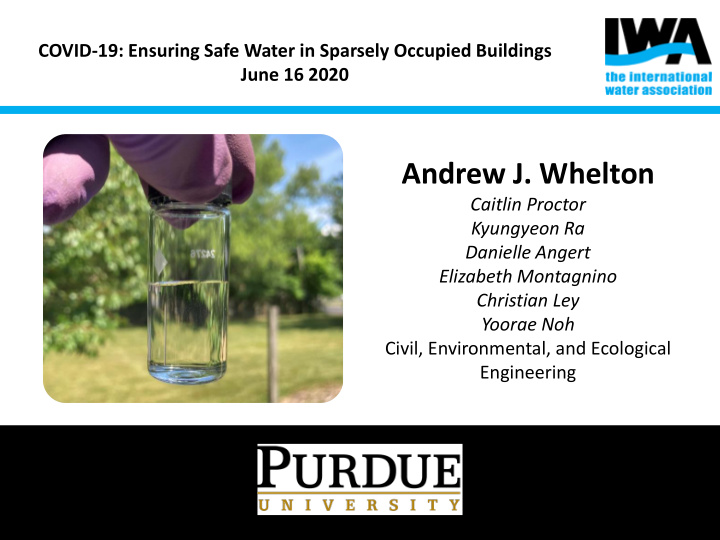



COVID-19: Ensuring Safe Water in Sparsely Occupied Buildings June 16 2020 Andrew J. Whelton Caitlin Proctor Kyungyeon Ra Danielle Angert Elizabeth Montagnino Christian Ley Yoorae Noh Civil, Environmental, and Ecological Engineering
More Information about Us www.PlumbingSafety.org Plumbing news Plumbing education videos Plumbing explainers List of projects Resources presentations Scientific opinions Scientific reports External plumbing docs 2
Lessons from the Field: Building Water System Interventions Stagnated water can poses health risks Copper leaching (can exceed safe limits in just 48 hours sometimes): Nausea, vomiting, gastrointestinal distress Lead leaching: D evelopmental issues with children and acute effects Harmful organisms e.g., Legionella pneumophila and other opportunistic pathogens: Many organisms cause respiratory illness, other infections can occur 3
Lessons from the Field: Building Water System Interventions U.S. National Science Foundation RAPID Award 2027049 Shutdowns and Consequences - Extreme Plumbing Stagnation and Recommissioning 1. State of science review of water stagnation with experts from 7 private and public sector organizations, [done] 2. Support to the plumbing and public health sectors on guidance and decisions, ongoing 3. Field testing to examine building water safety, ongoing 4. Lab testing to examine contaminated systems and devices, planned 5. Help transform public awareness, ongoing 4
Lessons from the Field: Building Water System Interventions DOWNLOAD FREE STUDY HERE https://doi.org/10.1002/aws2.1186 5
Lessons from the Field: Building Water System Interventions In the US, healthcare providers are being warned July 10, 2020 We have already had confirmed illness during the pandemic Staff member died (2019), Legionnaires Disease Staff member sick (June 2020), Legionnaires Disease Found LP in aerators at select locations including janitor sink 6
Lessons from the Field: Building Water System Interventions Safety: Exposure to Contaminated Water during Flushing and Heat Exhaustion Personal Protective Equipment OSHA and other worker safety agencies recommend respirators (N95) if Legionella is suspected or possible For respirators, medical clearance and a respiratory protection program is needed Reduce exposure by applying controls My personal warnings… Some people are sending workers to flush stagnant water that may have pathogens without any respiratory protection. Bad idea. Some people think “masks” are respirators. They are not. Persons with preexisting conditions should avoid this activity Getting a building flushed is a lot of work. Don’t do too much at once. 7
Lessons from the Field: Building Water System Interventions Lessons from a School, Indiana USA 3 buildings on campus, built in the 1960s 3 months of low to no water use, little irrigation use Characteristics • Public water supplier service area chlorine residual range <0.2 to 1.3 mg/L • Each building has 1 service line, 1 water heater, no recirc loops • Copper pipe, kitchen, classroom, bathroom sinks, toilets, water fountains; outdoor spigots; refrigerators, dishwashers, coffeemaker connected to the building water system; no showers, no cooling towers 8
Lessons from the Field: Building Water System Interventions Clean aerators Clean them Address all well outlets 9
Lessons from the Field: Building Water System Interventions Deal with water treatment Tackle high risk Flush appliances components 10
Andrew J. Whelton, Ph.D. Thank You. awhelton@purdue.edu More Information at www.PlumbingSafety.org Reports Coming Soon from Us in 2020: A look back at the Camp Fire disaster drinking water contamination School water copper and legionella contamination investigation Testing results of our ongoing rapid response water stagnation study 11
Recommend
More recommend